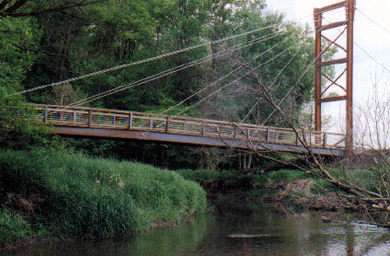|
Big Rock Creek Bridge provides a key pedestrian link in
the Big Rock Forest Preserve trail system. Located on 468 acres in south
central Kane County, IL (just west of Chicago), this recently developed
park is a triumph of conservation in the face of intense development pressures.
Despite rapidly expanding exurban cityscapes nearby, visitors to Big Rock
Forest Preserve are rewarded with a rare opportunity for viewing wildlife,
nature study, and hiking. A tributary to the Fox River System, Big Rock
Creek has been identified as a Class A stream, one of the finest and highest
quality streams in eastern Illinois.
Ann W. Davis writes the following of her Big Rock Forest Preserve experience
in Chicago Wilderness Magazine:
In early summer, as slivers of light sneak through the white oaks to
the east, a noisy kingfisher - seeking a meal of fish - skims above the
32-acre quarry lake at Big Rock Forest Preserve.
Since its initial acquisition in 1991 of land in the southwest corner
of Big Rock Township, the Forest Preserve District of Kane County (FPDKC)
has purchased additional parcels. Today, with roughly 468 acres, Big Rock
is among the district's largest properties.
When Big Rock Creek broke its banks during heavy rains in 1996, it burst
through to the abandoned limestone quarry beside it, filling the 65-foot-deep
pit and creating habitat for fish, including bluegill, black crappie,
largemouth bass, and sunfish. After building an access road, parking lot,
and pedestrian bridge, the district opened the site to the public.
We stroll northeast on an unpaved road that is sandwiched between Big
Rock Creek and the quarry lake. Below us, a ledge of dolomite bedrock
parallels the water's edge. Where the trail turns north, slabs of limestone
- skeletal remains from the property's previous quarry life - are stacked
cairn-like next to the path. Pointed stumps of silver maple and box elder,
now weathered silver-gray, hint that beaver once foraged here.
"Big Rock is at the edge of two major divisions in Illinois that are
defined by plant communities, glaciation, and topography," says Valerie
DePrez, FPDKC nature programs supervisor. "Where the rock shelf is exposed,
you can see scratches where the glacier left its mark 10,000 years ago.
Fossils in the limestone include creatures from the Ordovician period,
such as trilobites and brachiopods."
Farther on, we turn west. Hearing our footfalls, a pheasant hen bursts
from her hiding place. Goldfinches bob overhead and add their sweet notes
to the summer symphony. Visitors have seen other birds at Big Rock, including
osprey, brown creeper, Acadian flycatcher, scarlet tanager, barred owl,
tufted titmouse, and wild turkey. Hikers can reach the eastern portion
of the preserve by leaving the lakeside road and heading east toward the
oak grove along the ridge. Beyond that, the oxbows of Big Rock Creek snake
through a verdant valley lined by high, sandy bluffs. Along the creek,
massive sycamores tower over ironwood. Trees found in the 80-acre oak-hickory
woodland include red, white, bur, and chinquapin oak; bitternut hickory;
American and slippery elm; and purple mulberry.
"Other habitats at this diverse site include a high-quality fen and
a perched pond [a pond that rests on a shelf, usually clay, above the
water table]," notes Drew Ullberg, FPDKC director of planning and development.
Several years ago, the district seeded roughly 20 acres with prairie
grasses and forbs. Other native plants at Big Rock include wingstem, swamp
thistle, cup plant, spotted Joe Pye weed, sedges, cardinal flower, and
Canada wild rye.
Completed in 2005, Sahale's bridge at Big Rock Creek Forest Preserve
was subsequently awarded the American Council of Engineering Companies-Illinois
Special Achievement in Engineering Excellence. Kane County Executive Director
Monica Meyers writes in her letter to the Awards Committee:
"When the Forest Preserve District planned to span the creek with a
trail bridge, the primary goal was to protect this precious natural resource.
The District challenged the engineering team to implement a bridge design
without piers or permanent structures in the creek or the adjacent wetlands.
Furthermore, construction equipment or activities would not be allowed
in these sensitive environmental areas during the construction process. This
project fulfilled the District's mission of protecting and preserving
our natural resources for the education, recreation, and pleasure of all
its citizens. The engineering team surpassed the District's expectation
by using innovative construction techniques to protect the stream during
construction coupled with construction materials that will last a lifetime."
"This signature bridge has become a destination for forest preserve
patrons and provides a unique platform for viewing and photographing birds
and other wildlife."
|
 |
| Detailed View of Cable Stays.
|
|


